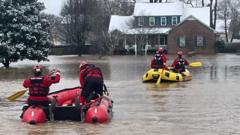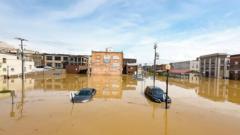**At least nine individuals have perished in flooding emergencies affecting several states, as rescue operations continue in the wake of catastrophic weather.**
**Devastating Floods Claim Lives Across Southeastern U.S.**

**Devastating Floods Claim Lives Across Southeastern U.S.**
**Torrential rainfall leads to fatalities, widespread rescues, and state emergencies amid ongoing efforts for disaster relief.**
At least nine lives have been lost this weekend due to relentless torrential rain that inundated parts of the southeastern United States, overwhelming roads and homes. Kentucky has recorded eight fatalities, prompting Governor Andy Beshear to predict that the toll might rise as rescue operations unfold. Hundreds of individuals were rescued from floodwaters where many were trapped in their vehicles; Beshear has urged people to "stay off the roads right now and stay alive." In Georgia, a ninth death was reported when a man was killed by a tree that fell onto his home while he was in bed.
This weekend, storm-related alerts were issued in Kentucky, Georgia, Alabama, Mississippi, Tennessee, Virginia, West Virginia, and North Carolina. Many of those states are still recovering from the destruction caused by Hurricane Helene in September. According to poweroutage.us, over 500,000 households across these eight states were without electricity late Sunday.
In Kentucky, where the majority of the fatalities occurred, reports indicated that both a mother and her seven-year-old child and a 73-year-old man were among the deceased. The National Weather Service (NWS) reported that some regions in Kentucky experienced up to 6 inches (15 cm) of rainfall, leading to widespread flooding. Rapidly rising river levels trapped numerous vehicles in deep water, with social media showing dramatic images of the destruction. Governor Beshear announced over 300 road closures and indicated he had reached out to the White House to request an emergency disaster declaration along with federal funds for the affected areas. President Donald Trump approved the declaration Sunday, enabling the Federal Emergency Management Agency (FEMA) to manage disaster relief efforts.
Officials warned that the worst of the flooding might still be ahead. Eric Gibson, director of the Kentucky Division of Emergency Management, stated, "The rivers are still going to rise." Bob Oravec, a senior NWS forecaster, added that there are still many swollen streams and ongoing flooding threats. In Tennessee's Obion County, the levee breach resulted in immediate and severe flooding. Local authorities warned residents in the area to seek high ground, emphasizing the life-threatening nature of the situation.
Rives, a town of about 300 located northeast of Memphis, was heavily affected by the flooding, leading its mayor to declare a state of emergency and mandate evacuations due to the dangerous conditions. West Virginia Governor Patrick Morrisey declared a state of emergency for ten counties, later expanding that number. Kristi Noem, head of the Department of Homeland Security, offered support to state officials, reiterating the local management of emergency situations.
Meanwhile, meteorologists are tracking a polar vortex heading towards the northern Rocky Mountains and northern Plains later this week, with temperatures in Colorado possibly plummeting to as low as 14°F (-10°C). Denver has already commenced preparations by opening shelters for the city's homeless population.
This weekend, storm-related alerts were issued in Kentucky, Georgia, Alabama, Mississippi, Tennessee, Virginia, West Virginia, and North Carolina. Many of those states are still recovering from the destruction caused by Hurricane Helene in September. According to poweroutage.us, over 500,000 households across these eight states were without electricity late Sunday.
In Kentucky, where the majority of the fatalities occurred, reports indicated that both a mother and her seven-year-old child and a 73-year-old man were among the deceased. The National Weather Service (NWS) reported that some regions in Kentucky experienced up to 6 inches (15 cm) of rainfall, leading to widespread flooding. Rapidly rising river levels trapped numerous vehicles in deep water, with social media showing dramatic images of the destruction. Governor Beshear announced over 300 road closures and indicated he had reached out to the White House to request an emergency disaster declaration along with federal funds for the affected areas. President Donald Trump approved the declaration Sunday, enabling the Federal Emergency Management Agency (FEMA) to manage disaster relief efforts.
Officials warned that the worst of the flooding might still be ahead. Eric Gibson, director of the Kentucky Division of Emergency Management, stated, "The rivers are still going to rise." Bob Oravec, a senior NWS forecaster, added that there are still many swollen streams and ongoing flooding threats. In Tennessee's Obion County, the levee breach resulted in immediate and severe flooding. Local authorities warned residents in the area to seek high ground, emphasizing the life-threatening nature of the situation.
Rives, a town of about 300 located northeast of Memphis, was heavily affected by the flooding, leading its mayor to declare a state of emergency and mandate evacuations due to the dangerous conditions. West Virginia Governor Patrick Morrisey declared a state of emergency for ten counties, later expanding that number. Kristi Noem, head of the Department of Homeland Security, offered support to state officials, reiterating the local management of emergency situations.
Meanwhile, meteorologists are tracking a polar vortex heading towards the northern Rocky Mountains and northern Plains later this week, with temperatures in Colorado possibly plummeting to as low as 14°F (-10°C). Denver has already commenced preparations by opening shelters for the city's homeless population.




















